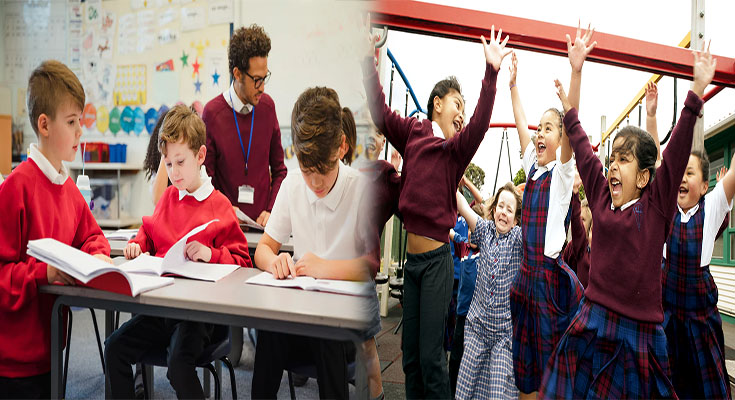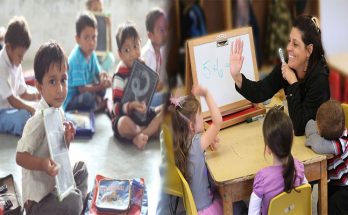Inclusive education is an approach to educating students with special needs that places them into regular classrooms instead of separate, segregated special education classes. Inclusive classrooms are typically set up in a way that allows all students to learn together. This means that a student who requires more specialized instruction might be taught alongside typically developing peers for 50% or more of his or her school day.
Inclusive education is the practice of educating students with special needs alongside their typically developing peers.
Inclusive education is not a new idea. It’s not a fad, trend, or movement; it doesn’t require you to completely rethink your teaching methods or philosophy. It does not require you to become an expert in special education law or learn how to interpret IEPs (Individualized Education Plans). Inclusive education doesn’t require any big changes whatsoever–you can start implementing it today!
Inclusive education is simply about providing all students with access to quality learning experiences regardless of their ability level or disability status. That means that if you are teaching math and one of your students has dyslexia and another has ADHD (attention deficit hyperactivity disorder), then both will receive modifications based on their unique needs so they can participate equally alongside their peers during the lesson without feeling left out, embarrassed or frustrated by their own limitations
Many students with disabilities receive instruction in special education classes, or are placed in special schools.
Inclusive education is the practice of providing all students with disabilities with the same opportunities to learn as their peers without special needs. This can be accomplished through a variety of methods, including:
- Instruction in mainstream classrooms (where all students are grouped together)
- Specialized instruction in self-contained classrooms (where students with and without disabilities receive separate but equal education) or resource rooms (smaller versions of self-contained classrooms)
The goal of inclusive education is to help students with special needs maximize their potential by allowing them to work alongside their typically developing peers.
Inclusive education is designed to help students with special needs maximize their potential by allowing them to work alongside their typically developing peers. In fact, it’s beneficial for all kids because it allows all children to learn from each other.
Inclusive education can be challenging for some schools, but it doesn’t have to be difficult if you have the right resources in place. Here are some tips on how you can establish an inclusive classroom or school environment:
- Make sure each child has an individual plan that outlines his or her specific needs and goals
- Place students at different levels within the same grade (eighth grade) so they can learn from each other through collaboration
- Use small group instruction as much as possible
There are several different kinds of inclusive classrooms, including resource rooms and self-contained classrooms.
There are several different kinds of inclusive classrooms, including resource rooms and self-contained classrooms.
Resource rooms are for students with special needs who may not be able to participate in the regular classroom curriculum–for example, if they have intellectual disabilities or learning disabilities. Self-contained classrooms may also be called special education classes or vocational programs; they’re intended for students with similar needs as those who attend resource rooms (i.e., intellectual disabilities), but often include a higher level of integration into the campus community than resource rooms do.
Self-contained classrooms are often based on specific curriculums and are not integrated into the rest of the school day; this means that teachers must plan their lessons carefully so that all learners can benefit from them equally regardless of where they sit during instruction time
Self-contained classrooms for students with special needs are often based on specific curriculums and are not integrated into the rest of the school day.
Self-contained classrooms for students with special needs are often based on specific curriculums and are not integrated into the rest of the school day. This means that the student spends most of their time with a smaller group of peers, rather than being taught alongside their typically developing peers.
One benefit of inclusive education is that it allows all children to learn from each other regardless of disability level or ability.
Inclusive education is a great way for kids with special needs to learn from their peers. It’s also beneficial for teachers, who can learn from all students and use their skills to teach students of all abilities.
One benefit of inclusive education is that it allows all children to learn from each other regardless of disability level or ability. In many cases, this means that kids with disabilities will have more opportunities to learn than they would in a traditional classroom setting.
Inclusive education benefits all kids
Inclusive education benefits all kids. It teaches students with special needs how to be role models for their peers and helps them develop empathy, a crucial skill in any academic setting. Inclusive classrooms also give all students the opportunity to learn from each other, which can benefit everyone involved. In addition, inclusive classrooms allow teachers more time to focus on teaching content rather than logistics or safety concerns related to having children with disabilities in their class.
Inclusive education has been proven to be beneficial for all students, regardless of disability level or ability. It allows students with special needs to work alongside their typically developing peers and learn from them in a way that isn’t possible in other settings. Students with disabilities can also benefit from learning alongside others who have similar struggles but may have different strengths or weaknesses than their own. Inclusive classrooms offer a variety of options for students who need extra help in certain areas without isolating them from their peers who don’t require extra support–this type of environment fosters positive peer relationships as well as promotes growth through collaboration





